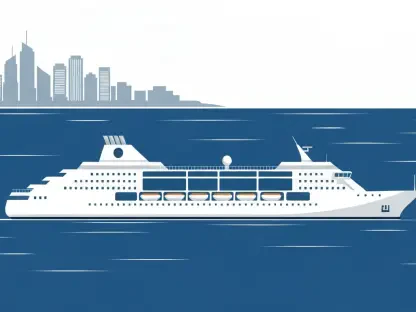Singapore Airlines has unveiled significant changes to its flight schedule for the Northern Winter 2025-26 season, marking a strategic shift in response to evolving global travel demands. This ambitious overhaul aims not only to enhance passenger experience and streamline operations but also to strengthen the airline’s position in the international aviation market amid fluctuating seasonal demands. With the increasing popularity of travel to destinations like New Zealand, Italy, and South Korea, these changes reflect a comprehensive response to the complexities of travel patterns and preferences, ensuring that the airline can deliver on its promise of efficient and comfortable service.
Strategic Adjustments and Aircraft Upgrades
Enhancing Comfort in High-Demand Routes
One of the key elements of Singapore Airlines’ strategy for the winter season involves upgrading aircraft on specific popular routes, enhancing luxury and space for travelers. Come January 2026, the airline plans to swap the Boeing 777-300ER for the Airbus A380 on the Auckland route. This change is designed not only to cater to the growing interest in travel between Singapore and New Zealand but also to provide passengers with greater comfort and luxury. Such upgrades represent the airline’s commitment to adapting its service offerings in line with passenger expectations, tapping into the increased demand for roomy and high-end travel experiences on long-haul flights during the winter months.
In addition to Auckland, other alternatives have been lined up for routes where demand remains robust. For flights connecting Singapore to Milan through Barcelona, temporary service pauses are being offset by increased flights connecting through Milan Malpensa. By employing the Airbus A350-900, the airline ensures continuity in services despite suspensions, allowing for seamless transitions amidst seasonal demand variations. This flexibility underscores Singapore Airlines’ strategic foresight in maintaining connectivity even as certain direct routes witness temporary suspensions.
Boosting Capacity and Connectivity
The airline is also expanding operations on the Singapore-Frankfurt route by increasing weekly flights from seven to thirteen starting January 2026, catering to heightened demand during the winter. This considerable expansion serves as a testament to the burgeoning interest in traveling to Germany from Singapore. Alongside this increase in frequency, the deployment of the Airbus A380 further elevates the travel experience, improving comfort levels and offering state-of-the-art amenities that are appreciated by passengers on lengthy journeys. The holistic approach in this expansion is indicative of Singapore Airlines’ comprehensive strategy to manage fluctuating demand effectively while ensuring passenger convenience.
Adjustments also include frequency reductions for destinations like Milan Malpensa and Munich in anticipation of reduced seasonal demand. By reducing from seven to five weekly flights for Munich between February and March, the airline aims to optimize its operational efficiency without compromising on service quality. These measured steps ensure that the operations are in alignment with anticipated traveler volumes, balancing supply with demand while preparing in advance for seasonal variations. Such strategic planning demonstrates the relevance of demand forecasting in optimizing resource allocation and maximizing service efficacy.
Responding to Seasonal Variability
Temporary Modifications in European Routes
As part of its strategic adjustments for the winter season, Singapore Airlines is recalibrating its flight operations to align with fluctuating demand patterns observed across its European destinations. This involves temporary frequency modifications for flights to Milan and Paris, aligning service offerings with the seasonal decline in traveler volumes projected during this period. With Milan Malpensa experiencing reduced frequency in February and March 2026, travelers are encouraged to make pre-planned arrangements, allowing them to enjoy uninterrupted access to their destinations while the airline optimizes its schedules.
Likewise, Paris Charles de Gaulle will witness slight dips in service frequency, particularly at points of expected lower demand, such as in November, late December, and early 2026. This tactical adjustment enables the airline to allocate resources efficiently, maintaining high standards of service while ensuring sustainability against fluctuating passenger interest. It reflects the balancing act of honoring passenger needs while adjusting to the intricacies of seasonal travel trends. Additionally, this proactive approach ensures that Singapore Airlines remains agile in responding to dynamic travel patterns predicted for these European hubs.
Flexibility Across Asian Destinations
Singapore Airlines is also diversifying its operations across popular Asian destinations, enabling capacity enhancements in key markets. As demand shifts in the regions, the airline offers flexibility and responsive scheduling that aligns with these changes. Temporary suspensions on the Seoul Incheon route are mitigated by alternative flight offerings through different connections, ensuring passengers can maintain consistent travel plans despite service modifications. Thus, while certain routes witness temporary pauses, Singapore Airlines upholds its commitment to comprehensive service provision across its network.
In particular, routes to Sydney, Manila, and Busan see beneficial adjustments, responding to growing travel demand within these regions. An upgrade to the Airbus A350-900 for Sydney flights from February through March guarantees passengers heightened comfort. Increased frequency of flights to Manila reflects the carrier’s dedication to providing superior services as demand for travel to the Philippines grows, enhancing connectivity while improving traveler satisfaction. Long-term planning for increased flights to Colombo introduces a refined travel experience between Singapore and Sri Lanka beginning in early January, demonstrating the thoughtful expansion into key Asian markets.
Seasonal Demand Adaptation and Passenger Experience
Addressing Peak Travel Demand in Japan
Japan remains a focal point in Singapore Airlines’ winter adjustment strategy, with flights to Sapporo New Chitose witnessing enhancements during peak winter months. To effectively capture increased interest in traveling to Japan during its famed winter period, the airline boosts its flight offerings, providing more options for passengers seeking both leisure and business travel opportunities. This enhancement in services corresponds to projected spikes in demand, aligning operations to meet passenger needs while ensuring seamless connectivity. The adjustments also include augmented flights to Tokyo Haneda in early December, facilitating increased travel during the holiday season, reaffirming Singapore Airlines’ commitment to providing responsive services tailored to passenger preferences.
A strategic component of this adaptation is the seasonal resumption of Taipei services starting in February. Identifying burgeoning travel interest in Taiwan, the airline modifies its service schedule to accommodate increased passenger demand. By adapting its operations to reflect these trends, Singapore Airlines positions itself as a premier carrier capable of navigating seasonal shifts with precision and finesse. The adaptability demonstrated in these enhancements is a core element of the airline’s broader strategy to maintain excellence in international aviation amidst seasonal fluctuations.
Enhancing Travel Options Across Asia-Pacific
Beyond European and specific Asian markets, Singapore Airlines extends its strategic modifications to ensure comprehensive connectivity throughout the Asia-Pacific region. Certain routes are seeing increased capacity to address growing demand, while the strategic deployment of aircraft enhancements aligns offerings with evolving passenger expectations. For instance, Sydney sees an aircraft upgrade to the Airbus A350-900, reflecting the airline’s focus on providing superior comfort and cutting-edge amenities for passengers during high-demand periods. Such upgrades not only enhance passenger experience but also optimize operational sustainability by aligning service offerings with projected passenger volumes.
In the case of Manila, the aircraft replacement strategy reflects a shift towards greater capacity provision, meeting the demand surge anticipated within the region. This change corresponds to an observed increase in passenger traffic, ensuring Singapore Airlines is equipped to handle fluctuating volumes without compromising service quality. Similarly, a frequency increase for Colombo flights underscores the airline’s ongoing commitment to delivering exceptional experiences across its network, reinforcing its position as a leading carrier within the Asia-Pacific. This proactive stance facilitates comprehensive connectivity, enabling Singapore Airlines to adapt promptly to shifting traveler demands across its extensive regional operations.
Navigating International Travel Dynamics
Comprehensive Connectivity and Strategic Responses
A cornerstone of Singapore Airlines’ winter flight schedule overhaul is ensuring robust international connectivity, underscoring the airline’s proactive approach to managing dynamic travel patterns. By aligning operations with seasonal shifts, Singapore Airlines endeavors to offer travelers more responsive flight options while enhancing service quality across its global network. The introduction of improved aircraft on high-demand routes signifies a commitment to optimizing passenger satisfaction, with comfort and efficiency remaining central to the service offerings. Temporary modifications in European routes represent a flexible strategy to maintain service excellence during projected downturns in demand, ensuring resilience in response to seasonal variations.
As global travel patterns exhibit dynamic shifts, Singapore Airlines is employing a comprehensive strategy that leverages meticulous scheduling and resource allocation. By embracing a multipronged strategy, the airline effectively manages both capacity enhancements and service reductions across its network. This adaptability enables Singapore Airlines to navigate international travel dynamics with precision, positioning itself as a premier carrier capable of delivering exceptional passenger experiences while addressing the nuanced demands of global travelers. The strategic approach also supports sustainability and efficiency in operations, reflecting the airline’s foresight in managing the complexities of international aviation.
Outlook for Enhanced Passenger Experiences
Singapore Airlines has announced notable adjustments to its flight schedule for the Northern Winter 2025-26 season, reflecting a strategic approach in response to shifting global travel trends. This extensive restructuring not only aims to boost passenger satisfaction and optimize operations but also aspires to bolster the airline’s competitive edge in the international aviation arena amidst changing seasonal demands. With a rise in the popularity of travel to places like New Zealand, Italy, and South Korea, these modifications are a thorough answer to the intricacies of evolving travel behaviors and preferences. The revised flight schedule is crafted to ensure the airline fulfills its commitment to offering efficient and enjoyable service, catering to various passenger needs. This move underscores Singapore Airlines’ dedication to keeping pace with the dynamic travel landscape, showcasing its proactive efforts to remain a frontrunner in providing top-tier service in the ever-changing world of air travel.









